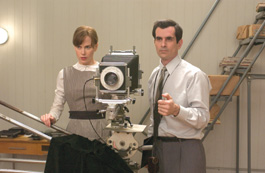home | metro silicon valley index | movies | current reviews | film review

Picture imperfect: Nicole Kidman and Ty Burrell can't seem to click in 'Fur.'
A Close Shave
In 'Fur,' director Steve Shainberg imagines the Diane Arbus we never knew
By Richard von Busack
THERE IS the Diane Arbus that we all know: the well-bred Manhattan photographer who urged herself to accept the most forbidden people of her day. And then there is the Arbus of Steven Shainberg's Fur: An Imaginary Portrait of Diane Arbus: a woman whose attraction to the hairier part of life lures her out of the depilated 1950s and into the hairier avant-garde. In this fantasy, Arbus (Nicole Kidman) waits in the disrobing room of a New Jersey nudist camp. In order to photograph the campers, she must be naked herself. In flashback, she remembers the road that led her here. She was lured away from her husband (Ty Burrell) by the arrival of a new upstairs tenant: Lionel (Robert Downey Jr.), who suffers from hypertrichosis, like Barnum's famed Dog-Faced Boy. Lionel beckons Diane with music and clues. After they become friends, he entices her into the night.
Shainberg has been getting roasted for tampering with Arbus' life, but the approach isn't as drastic as it seems. For decades, in one lying bio-pic after another, Hollywood films rewrote the lives of everyone from Mark Twain to Cole Porter. At least this film is honest enough to admit to the deception. Watching Fur, like watching Shainberg's previous film, Secretary, it's hard not to wonder about Shainberg's own life. For a time, he lived in a Zen monastery. An Imaginary Biography of Steven Shainberg might have him overcoming his own fear of the fierceness of the monks, realizing how their use of corporal punishment conceals their essential compassion.
Shainberg always defuses the relations between a master and a pupil—say James Spader to his employee Maggie Gyllenhaal in Secretary. The mysterious Lionel seems so forceful at first, sternly ordering Arbus to strip and bathe, or take a cup of tea. But he owns pet finches and bunnies to show that he is not to be feared. Arguably this is Shainberg's best idea: the fastest way to turn horror romantic is to show that a forbidding figure is kind to animals.
Downey endures what must have been excruciatingly itchy makeup. It's amusing to hear his covert, muttered tones as he tries to be a proper beast before he turns out to be as frightening as the Cowardly Lion. This furry muse of Arbus, when shaved, turns into a commonplace romantic figure. One echoes Garbo's complaint upon leaving Jean Cocteau's best-known film: Give me back my beast! Fur doesn't face the beastly side of Arbus—the cold clarity of the artistic gaze, which refused to acknowledge distaste.
As in Secretary, though, Shainberg has a lead that helps his peculiar scheme. Is the pale, enigmatic Kidman better in period films because the clothes do the acting for her? Her specialty—a woman being surprised by desire—always looks more impressive against an era when desire was more commonly repressed. All you have to do is look at Kidman's costumes here, to start to feel it's hard to breathe—those stiff formal suits, those underclothes that look like something designed by an orthopedic surgeon. Faced with those restraints, everyone would rebel, so the finale of Fur is less ultimate revelation than the typical fantasy of the artist's life: all freedom, no obsession.
![]() Fur: An Imaginary Portrait of Diane Arbus (R; 122 min.), directed by Steven Shainberg, written by Erin Cressida Wilson, photographed by Bill Pope and starring Nicole Kidman and Robert Downey Jr., opens Nov. 17.
Fur: An Imaginary Portrait of Diane Arbus (R; 122 min.), directed by Steven Shainberg, written by Erin Cressida Wilson, photographed by Bill Pope and starring Nicole Kidman and Robert Downey Jr., opens Nov. 17.
Send a letter to the editor about this story.
|
|
|
|
|
|